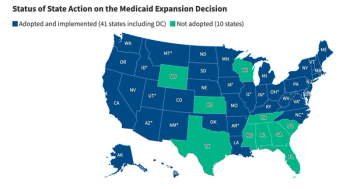
Study: Carving Out Hepatitis C Therapies from Medicaid Managed Care Increases Use
Greater uptake of hepatitis C medication may help improve the health of Medicaid enrollees and reduce the economic burden of untreated hepatitis C on the U.S. healthcare system, the authors said.
Carve-out benefits of antiviral hepatitis C medications from Medicaid managed care prescription drug coverage can increase access and reduce economic burden of untreated hepatitis C infections, according to a recent
A growing number of states have begun to carve out, or provide a separate coverage, for direct-acting antiviral hepatitis C medications, according to investigators. Instead of being covered by Medicaid managed care plans, these therapies are financed in some states through fee-for-service state Medicaid programs.
This study examined changes in prescriptions for Medicaid-covered direct-acting antiviral hepatitis C medications in four states (Indiana, Michigan, New Hampshire, and West Virginia) that carved out these drugs from Medicaid managed care between 2015 and 2017.
A synthetic control approach was used to compare changes in prescriptions between states that did and did not carve out these medications from January 2015 to June 2020.
State Medicaid programs often limit access to hepatitis C medications because of their high cost, with list prices ranging from $25 000 to $95 000 for a single course of treatment. Historically, access was limited through prior authorization requirements.
Investigators found that in the four states that implemented a fee-for-service coverage of hepatitis C medications, there was a mean quarterly increase of 22.1 prescriptions per 100,000 Medicaid enrollees, a relative increase of 86.3% compared with synthetic control states.
Prescriptions increased from 35.7% (Indiana) to 256.2% (New Hampshire) compared with their respective synthetic control states. Differences in medication use between treated states and synthetic control states also appeared to narrow over time. The authors speculate this may reflect pent-up demand for treatment for hepatitis C.
“Carve outs of high-cost medications may thus represent an important strategy for states to increase access to these medications, especially when combined with other approaches,” the authors wrote. “Under a capitated payment model, Medicaid MCOs face financial risk in delivering coverage of health care for their enrollees and have a limited set of strategies to mitigate this risk.”
An estimated 2.4 million people in the United States were living with hepatitis C during 2013–2016,
Newsletter
Get the latest industry news, event updates, and more from Managed healthcare Executive.





















































